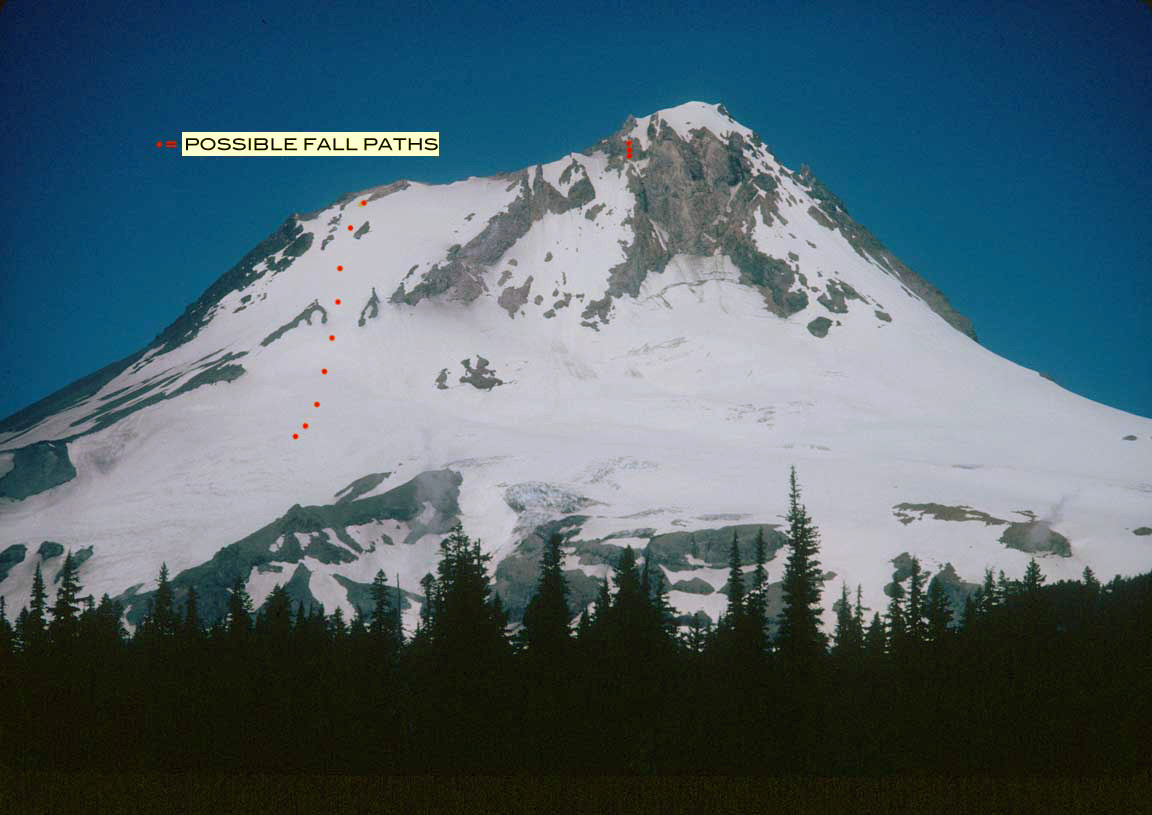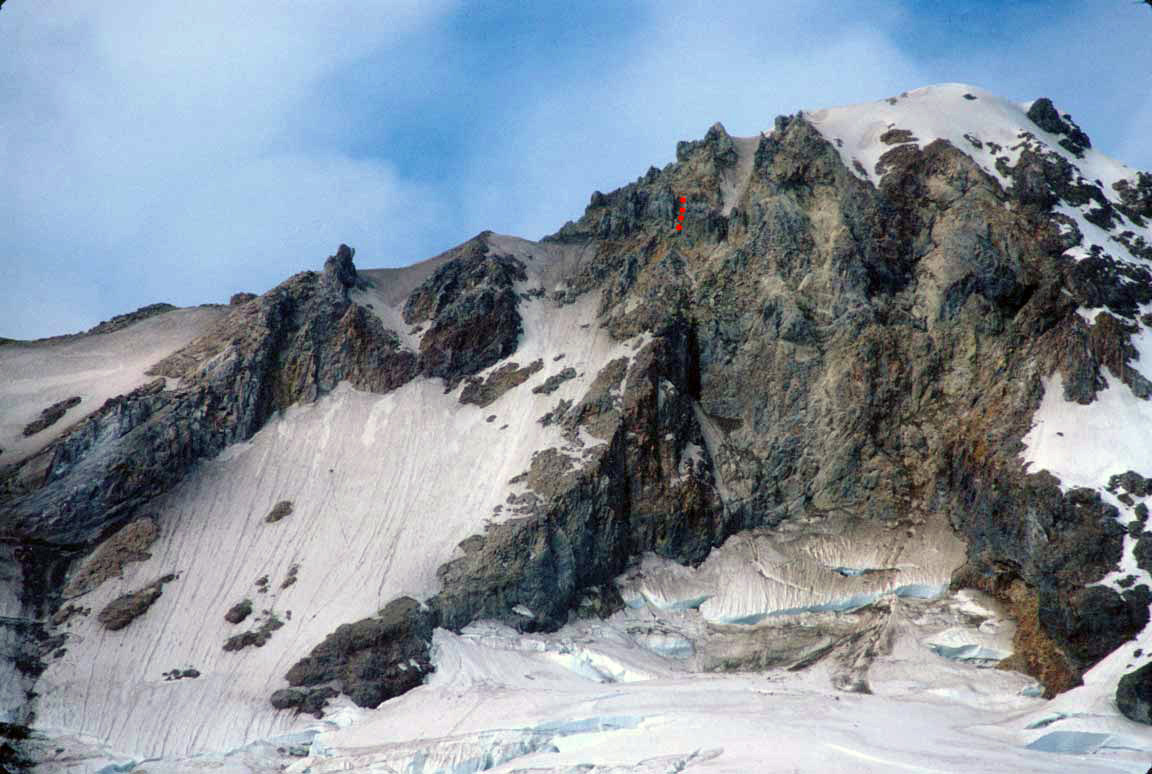ACCIDENT REPORT, MT. HOOD, 1971
By Ancil Nance
Three Portland climbers: Ancil Nance (30), Gene Kinder (15), and Tod Wagner (15) were involved in an accident near the top of the WyEast Route on Mt. Hood on February 7, 1971. The weather was clear, with a nearly full moon just around midnight and the temperature was below freezing. Up until the time of the accident, the climb had progressed smoothly and we three, while roped together, were moving together, not belayed. This may have been okay until we got to the series of chimneys and traverses which lead to the main 50º, 100-foot snow slope at the summit of the route. In retrospect it can be seen that upon reaching the chimneys we should have moved on belay, one at a time, because of the steepness and the exposure.
The accident occurred as we ascended a steep chimney that was coated with soft ice. Step chopping was no problem and there were even some steps from a previous group. As Nance reached the top of the 50 foot long chimney (with Kinder and Wagner a short distance behind), Wagner yelled “falling!” as he had missed a step while stepping back down to adjust his position. Almost instantly Kinder and then Nance were jerked from their footholds where they had been chopping more steps. As Nance was being yanked backward he had a second to mutter "Ohshitthisisit," thinking that the next stop would be a dead stop.
The impact of Wagner’s fall pulled both Kinder and Nance away from the ice and they flew and bounced down the chimney and onto the east face of Mt. Hood where Kinder came to rest about 50 feet below and to the right of his position at the time of the fall, and Nance landed about 100 feet below and to the right of his original position, on a ledge.
All three of us could have gone perhaps another 500 feet, but Wagner became lodged between two rock and ice outcrops about 20 feet below his climbing position. Kinder’s section of rope got caught on a rock and ice outcrop and Nance was caught by a ledge. A look at the scene of the accident in the summer revealed that the next stop below the ledge could have been the Newton-Clark glacier, 500 feet below. None of the equipment lost at that time has been found. It included two packs, ice axes, cameras, etc.
After the fall, we waited at the depression in the ridge just south of the chimney, until dawn, taking turns using the rope for insulation as we slept piled close together for warmth until about 4 AM and the first hint of daylight. We had only one ice axe, but we all had crampons, so getting back down presented no problems as long a we took it easy. All three of us were bruised and stretched. Kinder’s ribs hurt where his waist wrap had squeezed him while he hung when the rope caught on the rock after the fall. Nance had a 2 inch cut, ¾ inch deep in his right calf, caused by his left crampon. The cut and the blood were noticed at dawn when we began the descent. Because of the cold it is guessed that the bleeding and festering was less than normal.
Immediately after the fall Wagner and Kinder seemed to have had the clearest heads at the time. Nance showed signs of not being all there, in that he wanted to continue the climb up, and then later, on the way down he undertook a glissade on steep snow with no ice axe, thinking to use hand-held crampons for self-arrest.
This glissade attempt nearly ended in disaster as about 300 feet into the glissade (sitting), Nance hit ice, lost control completely, and rolled, tumbled, and cart wheeled down another 600 feet, flying over a crevasse. He was stopped by a soft snowdrift. He was thoroughly stretched in every joint, the calf wound was bleeding a great deal, and he had a sprained ankle. (Note: I recall thinking during my tumble down the SE slope that this was really dumb, having survived the accident last night, only to die now.) About 45 minutes later Wagner reached Nance who had been resting and taking care of the calf wound with a handkerchief bandage. All three of us then proceeded down, which meant first ascending the SE ridge, and due to his wound and ankle, Nance told the other two to go ahead and see if a Sno-Cat® could be dispatched. They soon disappeared, and by the time Nance made it to the ridge top the sun had taken a toll on his eyes. (Note: I began to imagine seeing large machines moving across the snow, only to find as I got closer that the shapes were large rocks.) The Sno-Cat® arrived while Nance was still poking along above the skiing zone.
The ski patrol performed first aid on the calf wound at 5 PM, and with an air-splint on his leg the ski patrol wondered who would drive. Luckily, Kinder had a learner's permit and climbed in behind the wheel. Nance was in bed for two weeks after the accident. Wagner and Kinder were back at school in 2 or 3 days.
Analysis (Nance): The accident could have been prevented had the leader set in some ice screws, and had each climber then moved one at a time on belay. A slip on belay would not have hauled all three climbers down. The ice screws were lost along with the pack, where they were at the time of the accident. Screws were not used because of the apparent easiness of the route, the good ice, and overconfidence.
When I arrived home that evening the phone was ringing. It wa my aunt Ruby. She asked if I had watched the news and wanted to know if I knew the guy who was filmed by KGW's Bill Kiel falling 2000 feet down the SE slope of Mt. Hood.

